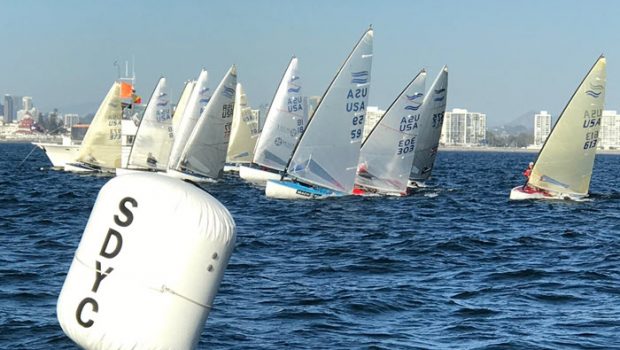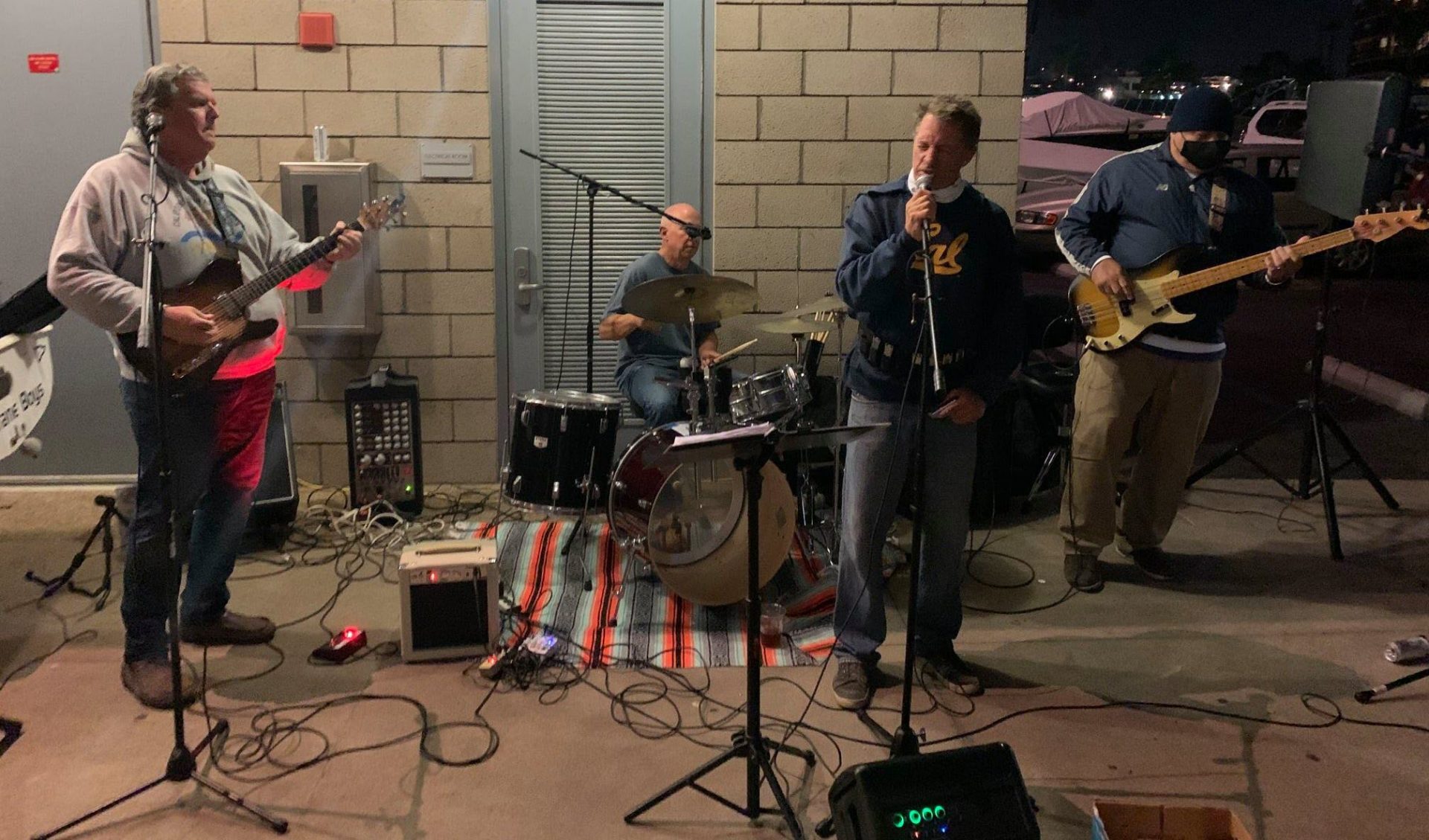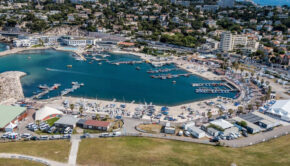Finn fleet revival in California
Published on June 2nd, 2021
In The One Design Line, US Sailing’s e-Newsletter for one design sailors, Chris Snow shares a report about one design class fleet building:
Mike Dorgan is the founder and current captain of the San Diego Finn Fleet. He is a lifelong sailor and has a strong background of successfully sailing many types of boats most notably the Star. Mike is a past commodore of San Diego Yacht Club (SDYC) and has his own yacht brokerage business Dorgan Yachts, Inc. founded in 2009.
He has taken the local Finn fleet from literally one Finn in 2015 to over 22 Finns sailing out of SDYC, including helping to build the Misson Bay Yacht Club Fleet Finns (10) and reviving the Long Beach and Newport Harbor Fleets as well through his role as California Finn Vice President.
I sat down with Mike to find out how he accomplished this and what advice he might have for anyone wanting to start a new fleet or grow an existing one.
San Diego has a long history of one design sailing from the smaller sized classes like the Snipe and Lightning at Mission Bay Yacht Club to the Star and Etchells at SDYC. Why start a Finn fleet?
I have raced many one design classes like the Star, Etchells, and our family-owned cruiser, and raced a larger sailboat the Beneteau 40.7. Over the years, I have not only raced these classes but also been asked to be Fleet Captain, run events, set schedules, awards, and bid for National and World Championships. More and more, I found myself not only having to get crew for my own boat but then calling around to get people to crew on other boats to get them out sailing. Couple all of that with being a ’Sabot Dad” while enjoying young children in the Junior Program and always supporting their sailing, I found myself reverting to sailing the Finn more and more.
Sailing a single person boat is very simple: show up at the club, throw on your hikers, toss the boat cover, roll the Finn down the ramp, and you are sailing in 5 minutes! No excuses, no one to call or wait on. No organizing a large crew including lunches, team shirts, party dinner tickets, drinks, etc. And, while I love the big boat program, when it is paired with a young family, running a business, volunteer time on the Board of Directors and ultimately becoming Commodore of SDYC, there just wasn’t enough time in the day to do it all.
Another reason I started the Finn fleet was there was a growing number of older guys that wanted to get back into sailing. For a nominal amount, you could pick up a reasonably competitive Finn and just go sail your boat! No one was yelling at you, telling you to hike harder. Plus, the Finn gives the average sailor a chance to call his own tactics and put it all out on the line.
Personally, I spend most of my days talking to people about their boating solutions, negotiating boat deals for clients looking for the perfect power or sailboat always for less than what a seller is asking… so, when I am out on the water, it is an opportunity to be one with the sea, to enjoy the wind blowing, the water trickling by and the sound of silence which I think we sometimes take for granted in this hectic world.
You had to start somewhere. Who were the original members of the fleet and how did they become interested?
I started sailing my older Vanguard with an older Needlespar aluminum mast and dacron sail at the same regattas our two children were sailing. I would race the Finn, my son Matthew in the Laser, and daughter Millie in the Sabot, and mom got to go on a nice quiet walk! After a few regattas, I saw a post on Facebook by MBYC member Rich Wright with a picture of his Finn on the beach getting ready to sail on Mission Bay.
I reached out to him, met a couple of the guys, started sailing over at Mission Bay and helped them build their fleet. While I love Mission Bay, with the help of the Finn Class, I was able to secure a loaner Finn for my son to sail (now 6’6”) and he started sailing with us at SDYC. Other club members started picking up Finns and would get engaged, sell their older boats and upgrade to newer Finns. I would always try and keep the older boats within our fleet or area so that new Finn owners would stay and sail with us.
During my Commodore year, one event that was really beneficial in helping grow the fleet was the “Sail A Dinghy Day,” inviting both yacht club members and guests alike to the SDYC Small Boat Yard and the Star hoist platform. We had different one design sailboats set up on dollies and in the water for people to test sail.
Aside from several Finns, we had Lehman 12s, Lasers, FJs, a Snipe, and a couple of the club-owned J/22s. The day was VERY successful with over 80 participants signing-in and many more just walking by, looking, talking to some of the fleet members even though they did not sign in or go for a sail. I think we sold 2-3 Finns because of this single event!
As far as I know, Finns are not built in the US. How do you/did you get boats for your fleet?
The internet has been an awesome tool for finding boats for sale, and here in San Diego, we were lucky to have the 2008 Finn Olympic Trials in Newport Beach. There were a lot of guys buying new Finns for the Trials and after the Trials, the fleet started to die. There were guys with boats in the garage, under covers, or just sitting at the club unused. We located and bought a lot of these boats for our sailors in the San Diego area.
Another source for Finns were the older Vanguards, the same make, and model I owned for over 20 years. On my older boat, by fairing the bottom, re-spraying the bottom and deck, replacing the hardware, and putting a modern carbon wing mast on it, it was as fast as the best guys in the newer tricked out Finns in most, if not all, of Southern California conditions. Older Vanguards could be picked up for a couple of thousand dollars and with a little time, effort, and money, they could be brought back to life and have years of sailing left in them.
And the last source of boats is through my close relationship with a company in the States that sells Finns, Finn gear as well as other small one design boats. They would help coordinate guys wanting new masts, gear, and/or boats to get together on a container shipped from Europe where most of the competitive Finns are built.
How often and where does the fleet sail?
We sail two to five times a month, depending on the schedule. We try and move the fleet around Southern California to include several different venues with varied conditions: San Diego Yacht Club, Coronado Yacht Club, Mission Bay Yacht Club, Alamitos Bay Yacht Club, and Newport Harbor Yacht Club. In 2021, we plan to sail in the San Francisco Bay Area out of St. Francis Yacht Club, where there used to be a strong fleet in the Bay Area but most of them have since moved away.
We’re also planning for regatta in Alpine at 5,000+ elevation, which is always fun! By moving the fleet around, it keeps it interesting and allows the different sized sailors to have the perfect conditions for their size, so we are not just sailing at one venue that might just fit one type of sailor. We even have some races that are around the bay, point to point races which can be fun.
Where else does the fleet travel?
We also travel across the country to regattas like the Finn Nationals, North Americans, Midwinters, or State Championships. Several guys, including myself, have multi-level trailers so some of us will drive a rig with some boats, and the other guys will fly into the venue, sail, then pack up, and I’ll drive back. They pitch in a little gas money to help cover costs, and it enables guys with busy schedules to be able to do more out-of-town events.
How many boats are currently in the fleet? Are they all from San Diego Yacht Club?
The Finn fleet is composed of boats from two fleets in San Diego. At SDYC we currently have about 22 Finns, and over at MBYC there are about 10.
There’s also 15+ Finns between Newport, Alamitos Bay, and Long Beach. In 2020, which was a tough year to get people out sailing due to the pandemic, we had 39 Finns sail in our High Point Trophy—not a bad year!
What are some things you do to get people engaged in the fleet and keep them coming out?
The biggest thing is making it fun. If it’s not fun, sailors will find something else to do. We have promoted racing in one design weekend regattas which are free monthly regattas run by our San Diego Yacht Club’s highly competent Race Office and volunteers. Everything is set up with electronic entry forms, NORs, SIs, and even tows out to the racecourse. Just sign, up, show up, and sail!
On Saturday night, we get sponsors to donate beer and other beverages and have an after-race social in the parking lot. And to make things even more fun, during the Finn North American Masters Championships, some Finn guys who play music put together a band to play some tunes. It was a great time!
Now, over two years later, the “Finn Band” will regularly play music on the Saturday night of our One-Design Weekend—all for free! We sit around, drink beer, listen to live music, get to know one another, and learn all the little sailing tricks and nuances that make a Finn go fast.
Another great tool is social media, more specifically, the California Finn Association Facebook page. Every time I sail, I bring a waterproof camera and take photos of everyone sailing, racing, or in the parking lot afterward. I post pictures and write up a little story and try to recognize guys finishing in the middle of the fleet. Before the racing, we ask some of the Race Committee volunteers to snap a few pictures or invite photographers to come out and shoot the bigger events.
Directly after the event, and even sometimes from my Finn, I post pictures and/or results ASAP. Sailors from around the nation are able to see the beautiful weather and the Finns sailing, and they get excited. Then my phone rings and we pick up new sailors. We also post stories in the SDYC Monthly Mainsheet magazine as well as the MBYC publication.
I have also come up with interesting trophies and often award them to sailors not just at the top, but guys making improvements in the fleet, or maybe award a spectacular Finn capsize and wipe-out, or the “Half Page” winner after I folded the results page in half, the sailor on top that sailed all the races won an award equal to the Finn winning the championship.
Lastly, I think that a set time and place for weekly outings is important for guys just to get out on the water, sail their boat and get a little practice in. Sometimes, I will meet with the newer fleet members and go over rigging, sail shape, mast position, or just overall techniques for sailing the boat.
Do you have any advice for someone thinking about starting a new fleet?
If someone has the passion to start a fleet, anything is possible, especially with today’s technology and abundance of one design sailboats around the country not being sailed.
One of the best tools for building a fleet is using the good, old-fashioned phone. There is nothing better than having a one-on-one conversation with someone thinking about going sailing. By touching base with current fleet members, we can keep them engaged and find out if there’s anything we can do to help get them up to speed, work on their boat, mast measurements, or picking up used sails or gear to help them improve on the water.
With the benefit of hindsight is there anything you would have done differently to start and grow the fleet?
No regrets, other than maybe I should have started building new Finns in the US, but then it would go from something I do ‘after work’ to becoming work!
In your opinion, what is the most important things to having a successful and active fleet?
By far I think the number one thing for a fleet to be successful is you need one or more “Spark Plugs”. You need someone calling people to get them out sailing, to show up at regattas, help with rigging, tuning, finding boats, or selling their boats if they are ready to get into a newer boat. You need someone to post pictures, no matter what quality, and post articles on social media, send out monthly regatta reports and newsletters, always touching base and encouraging sailors to sail their boats.
There have been many times that I have spoken with someone who is thinking about selling their boat, but after our conversation, they would get re-invigorated and want to sail again. Every fleet needs someone to breathe life into it, help build it, and help sailors to reach their potential. When the fleet is improving, everyone is then having fun and improving at the same time!
For additional resources and information, click here.
About the Author:
Chris Snow is currently Chair of US Sailing’s One Design Committee. Chris is a professional sailor and coach living in San Diego, Calif. He was formerly the One Design Manager for North Sails in North America. To engage Chris’s services individually or for your group or club please e-mail him at chris@thefavoredend.com. You can learn more about Chris and get some more sailing tips at his website www.thefavoredend.com.










 We’ll keep your information safe.
We’ll keep your information safe.